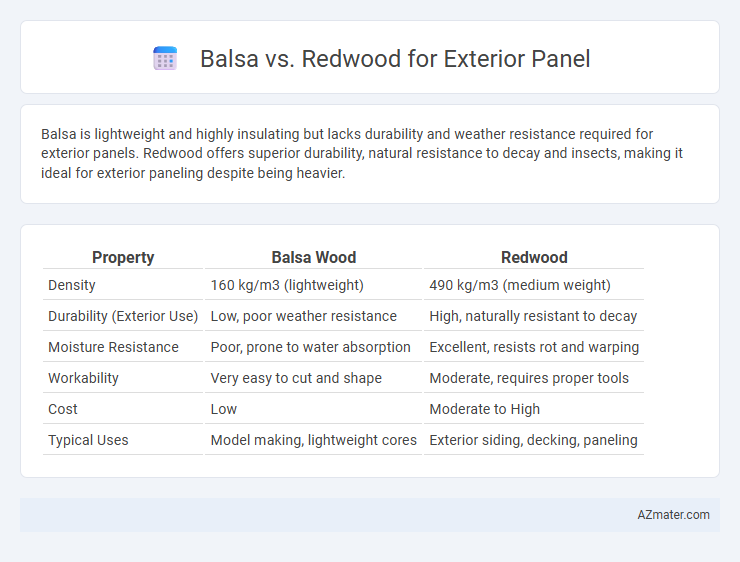Balsa is lightweight and highly insulating but lacks durability and weather resistance required for exterior panels. Redwood offers superior durability, natural resistance to decay and insects, making it ideal for exterior paneling despite being heavier.
Table of Comparison
| Property | Balsa Wood | Redwood |
|---|---|---|
| Density | 160 kg/m3 (lightweight) | 490 kg/m3 (medium weight) |
| Durability (Exterior Use) | Low, poor weather resistance | High, naturally resistant to decay |
| Moisture Resistance | Poor, prone to water absorption | Excellent, resists rot and warping |
| Workability | Very easy to cut and shape | Moderate, requires proper tools |
| Cost | Low | Moderate to High |
| Typical Uses | Model making, lightweight cores | Exterior siding, decking, paneling |
Introduction to Balsa and Redwood
Balsa wood, known for its exceptionally lightweight and soft texture, offers excellent insulation properties and ease of handling, making it a popular choice for exterior panels requiring thermal efficiency. Redwood features a dense, durable structure with natural resistance to decay and insects, providing long-lasting protection and a rich aesthetic appeal in outdoor applications. Both woods are valued for their unique benefits, with balsa excelling in insulation and workability, while redwood delivers superior durability and weather resistance.
Physical Properties Comparison
Balsa wood is significantly lighter, with a density of around 160 kg/m3, compared to redwood's density of approximately 450 kg/m3, making balsa ideal for applications requiring lightweight materials. Redwood exhibits superior durability and resistance to decay, thanks to its natural oils and higher density, which also contribute to better insulation and structural stability in exterior panels. Physical properties such as compressive strength and moisture resistance favor redwood, ensuring prolonged lifespan and lower maintenance in outdoor environments, while balsa's softness limits its use to non-structural or protected exterior applications.
Weather Resistance and Durability
Redwood offers superior weather resistance compared to balsa, making it highly suitable for exterior panels exposed to rain, UV rays, and varying temperatures. Its natural oils and dense grain structure provide enhanced durability, reducing the risk of warping, cracking, and decay. Balsa, while lightweight and easy to work with, tends to absorb moisture quickly, leading to diminished longevity and performance in outdoor applications.
Weight and Workability
Balsa is significantly lighter than redwood, with a density around 160 kg/m3 compared to redwood's 450 kg/m3, making it ideal for applications where weight reduction is critical. Its low density contributes to excellent workability, allowing for effortless cutting, shaping, and sanding, which accelerates installation and customization. Redwood, while heavier, offers moderate workability but requires more effort to machine due to its denser grain structure and natural oils that can affect tools.
Insulation and Energy Efficiency
Balsa wood offers superior insulation properties with a thermal conductivity of approximately 0.10 W/mK, making it highly efficient for exterior panels in reducing heat transfer and improving energy efficiency. Redwood, while durable and resistant to moisture, has a higher thermal conductivity near 0.13 W/mK, making it less effective than balsa as an insulating material. Choosing balsa for exterior paneling enhances building envelope performance, leading to lower energy consumption and better temperature regulation.
Sustainability and Environmental Impact
Balsa wood is highly sustainable due to its rapid growth rate and ability to sequester carbon, making it an eco-friendly option for exterior panels. Redwood offers natural durability and resistance to decay, reducing the need for chemical treatments, which minimizes environmental pollution during its long lifecycle. Both woods provide renewable choices, but balsa's faster renewability and lower density typically result in a smaller carbon footprint compared to the slower-growing, more resource-intensive redwood.
Cost and Availability
Balsa wood is generally more expensive and less readily available compared to redwood for exterior paneling due to its limited regional growth and specialized harvesting. Redwood is widely sourced from the western United States, offering a more cost-effective and abundant option for exterior applications. While balsa provides excellent lightweight qualities, redwood's balance of affordability and availability makes it the preferred choice for many exterior panel projects.
Maintenance Requirements
Balsa wood requires minimal maintenance for exterior panels due to its natural resistance to moisture and rot, but it benefits from regular sealing to prevent surface wear and UV damage. Redwood offers superior durability and naturally resists decay and insects, resulting in lower overall maintenance efforts, although periodic staining or sealing can enhance its lifespan and appearance. Both woods demand attention to protective coatings to maintain their structural integrity and aesthetic appeal in exterior applications.
Best Applications for Exterior Panels
Balsa wood offers excellent insulation properties and lightweight advantages, making it ideal for exterior panels in energy-efficient buildings and cladding systems subject to minimal structural loads. Redwood's natural resistance to decay, moisture, and insect damage makes it highly suited for exterior panels exposed to harsh weather conditions, such as siding, fascia, and decorative facades. Combining durability with aesthetic appeal, redwood excels in long-term exterior applications where strength and weather resistance are critical.
Conclusion: Choosing the Right Wood
Balsa offers exceptional lightweight properties and ease of handling, making it ideal for applications where weight reduction is critical, but it lacks the durability and weather resistance needed for long-term exterior panel use. Redwood, with its natural resistance to decay, insects, and moisture, provides superior longevity and minimal maintenance in outdoor environments, justifying its higher cost for exterior applications. Selecting the right wood ultimately depends on balancing weight concerns against durability requirements, with redwood being the preferred choice for robust, weather-resistant exterior panels.

Infographic: Balsa vs Redwood for Exterior panel
 azmater.com
azmater.com